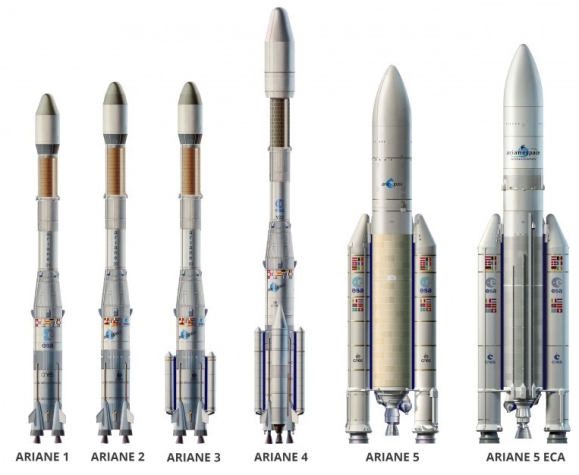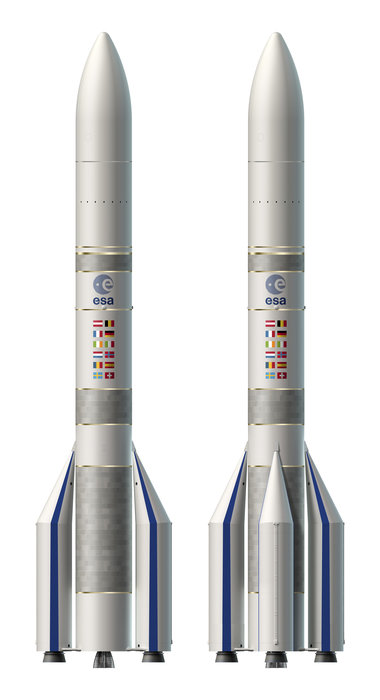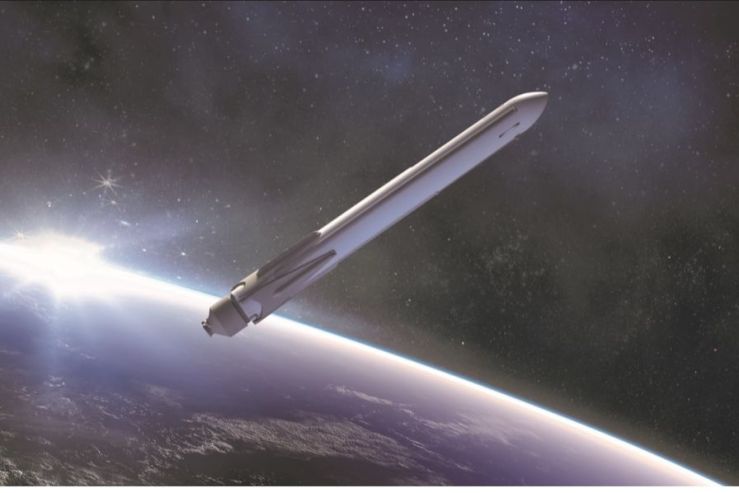Another month, another CNES café, this time on Ariane 6 and future launchers. While it is not strictly speaking Earth Observation, launchers and the launch market have a direct impact on observation satellites through the mass and volume constraints, and the launch price. So it is worth looking into what CNES has to say about their new rockets, Ariane 62 and Ariane 62.
The speakers were Jérôme Vila, assistant director for research and future programs at the CNES launcher directorate, and Alain Dupas, an adviser to CNES.

Winds of change
Much has been written on the recent changes in the launch market, and different actors have different points of view. So what is interesting in the description the speakers gave of Ariane’s place in this industry is that it reveals how CNES sees things, even if the merits of the arguments can be debated.
Vila started the talk by saying that the Europeans used to rest on their laurels with Ariane 5, content of their large share of the commercial launch market. However, due to changes in the satellite market, they are pushed to innovate.
The first space market is satellite communications, which are often used to broadcast TV channels to large regions. He pointed out that innovations in information technology have brought a lot of changes to the communication market, and satellite communications are impacted by it. The second space market is Earth observation, which used to be the privilege of states, and is now becoming more and more commercial.
Dupas concurred, stressing that Ariane had 50% of a very stable commercial market in the last few years, but had no access to the very large US government market however. Until recently this market was almost a ULA monopoly, and SpaceX is a challenge to them as well.
The moderator, a journalist specializing in space topics, intervened and reminded the two experts that 6 years ago, he interview European rocket engineers, and they told him that reuse was almost technically unfeasible, and if it was feasible, it would never be profitable. So, he asked, has CNES changed its mind on the economics on reuse? Dupas answered that the megaconstellations that are planned to launch shortly make reuse financially relevant.

Ariane 6
The discussion then moved on to Ariane 6’s competitive advantages compared to its predecessor Ariane 5. Vila described Ariane 5 as very much hand-crafted, whereas Ariane 6 will be much more industrial. He said it will be half the price of Ariane 5 and confirmed it will launch in 2020, a relatively short timeline made possible by the experience gained on Ariane 5. He also reminded the audience that a medium version, Ariane 62, will be introduced, and it will replace the Soyuz rockets currently launched from French Guyana, thus increasing the launch rate and lowering the costs. Finally, he said new technologies such as additive manufacturing bring down costs too.
Q & A
After this short introduction, the session moved to Q & A with the audience.
Q: How did CNES get its assessment of reusability so wrong?
A: The market has changed, demand is increasing so reuse works better economically: we did not forecast the appearance of megaconstellations. SpaceX was also supported by captive US government launches, which Ariane does not have: SpaceX launches are 2/3rd government, 1/3rd commercial whereas for Ariane it is the opposite. Finally, we underestimated SpaceX’s technical prowess: they got a lot of skills and technologies from NASA’s R&D programs.
Q: Is Ariane 6 good for megaconstellations?
A: It’s a good start… but we will need to make modifications if we are to sell 50 launches to fill a constellation quickly. For that we need to reduce costs and increase launch rates. As a comparison, SpaceX will probably be able to do 100 launches a year in 2 or 3 years. Ariane 6 offers some flexibility for constellation deployment thanks to a reignitable upper stage and a large fairing volume: for constellations rockets are more volume-limited than mass-limited. It will also have an undisclosed engine on the upper stage in addition to Vinci, giving it Fregat-like maneuvrability. [Note: it’s a 3D-printed Auxiliary Power Unit that burns hydrogen and oxygen to pressurize the tanks and allow for Vinci restarts, like ULA’s IVF]
Q: Is it suited to cubesat deployment?
A: Pooled rides to a dedicated orbit on Vega or PSLV are better suited, and so are rideshares along the main payload of Ariane 6. It will have a late-load option for secondary payloads, up to a few weeks before launch. For launches of a single cubesat, Vega is too large and there are many microlauncher projects all over the world.
Dupas: Europe should develop a microlauncher [note: Airbus tried to develop a solid-based microlauncher called Sparrow and found no European venture capital for it]
Q: What are the performances of Ariane 6?
A: You can look it up on wikipedia, but keep in mind that performances are not the good metric. Rather, it is cost and the market suitability.
Q: What will happen to Soyuz launches from French Guyana?
A: We will see, but note that this rocket launches a lot of institutional European missions even though it is not European. Also, you can’t image how “inventive” the Russian are on the prices. Ariane 62 will be cheaper.
Q: What about air-launching future rockets?
A: Launch from a plane at 10km is not very interesting. Launch from a ballon at 40km altitude is more so, since there is no air resistance there.
Prometheus and Callisto
The CNES officials then spent some time describing Prometheus, an engine in development by Airbus as part of a CNES and ESA project. Its aim is to reduce the costs by a factor of 10, and the first test fire is planned in 2020. It is a methane-oxygen engine, like the Raptor engine SpaceX is developing. Russia is also developing one, although it is unclear what for. They emphasized that methane is much simpler to work with than hydrogen.

They also described the Callisto project, a reuse R&D project, and compared it to the research projects NASA did on reusability in the 1990s. Callisto will be a 1-stage rocket that will reach 50km altitude at Mach 2/3, then reenter and land at the launch site.
Musk’s plans
Dupas told an anecdote: in 2004, he was the fist European visitor at SpaceX and no european leader to Musk seriously. So he advised caution about SpaceX’s BFR project, saying it is not a remote project for Musk. Still he mentioned that for Musk, the dates in a plan are much more of a tool to motivate employees than realistic estimates: BFS, the reusable second stage, has its first flight scheduled next year, and the first flight to Mars is planned for 2022. Dupas said it would be more realistically 2024 or 2026.
The moderator remarked that nowadays, you do not hear CNES laughing about SpaceX plans anymore.
Back to Q & A
Q: Do you think China will increase its share of the commercial launch market?
A: China is renewing its launcher fleet, but is more focused on domestic and defense uses than on the commerical market.
Q: What happened to the Adeline reusable engine pod project, that was to fly back the engines to the launch site?
A: We investigated the concept and found it not financially interesting
Q: Will Ariane 6 be man-rated?
A: Human exploration will be done in cooperation with other countries, and the USA are developing a launcher for human exploration, so no Ariane will not be man-rated. However nowadays manrating would not be done by increasing the margins in the design, but by using a proven commercial launcher with a good track record.
Q: If Prometheus is so cheap, it will replace Vulcain, the solid boosters and Vinci. What will happen to their industrial base then?
A: We have time to see. If the market pressure is light, we might only swap Vulcain with Prometheus, and keep the solid boosters. If the pressure is strong, we will swap everything, but the solids are still used for ICBMs and the industry prefers defense contracts anyway.




I looked at SpaceX 2017 launches and out of the 18 only a total of 6 were for NASA/USAF so its only 1/3 government and 2/3 commercial. Also if you look at the schedule for 2018 only 9 out of the 30 in the books is for government.. Just saying..
LikeLiked by 1 person
Agreed, but that’s what he said. However in the past the government fraction was higher, in 2015 it was 4/7, close to 2/3.
LikeLike
A good corporate leader has to look to the future, and assessing your competition (SpaceX) by where they were 3 years ago is not a good idea. SpaceX was still experimenting with their Falcon 9 back in 2015, trying lots of different things, and back then no two Falcon 9 were built the same way, and in trying different things they suffered two disasters (CRS-7 and AMOS-6) and learned quickly what works and what doesn’t. They have rapidly matured and now Falcon 9 is flying in its final stable configuration (Block-5), and the company’s launch business has also similarly matured. You cannot expect SpaceX to rely on the U.S. Government for 2/3 of its business going forward, as 2017 and 2018 is demonstrating. In the future the majority of SpaceX’s business will be commercial, not government.
It is also wrong to attribute SpaceX’s prowess to “technologies and skills from NASA R&D.” NONE of SpaceX’s retropropulsive landing on drone ships had anything to do with NASA, it was developed in-house. NASA’s R&D mostly benefited the Dragon capsule, such as technology for the Phenolic-Impregnated Carbon Ablator (PICA) heat shield for capsule re-entry.
Sounds to me like Europe is still underestimating Elon Musk, and that is a dangerous thing for Europe’s aerospace industry to do.
LikeLiked by 1 person
[…] am talking about sovereignty, so I am talking about the Ariane 6 project. I already had the opportunity to say it a few months ago at the ArianeGroup offices, but I repeat […]
LikeLike
[…] and Space является новая ракета-носитель Ariane 6. А в 2018 году появилась информация, что проект не вызвал интереса по […]
LikeLike
[…] and Space является новая ракета-носитель Ariane 6. А в 2018 году появилась информация, что проект не вызвал интереса по […]
LikeLike
[…] and Space является новая ракета-носитель Ariane 6. А в 2018 году появилась информация, что проект не вызвал интереса по […]
LikeLike
[…] and Space является новая ракета-носитель Ariane 6. А в 2018 году появилась информация, что проект не вызвал интереса по […]
LikeLike
[…] and Space является новая ракета-носитель Ariane 6. А в 2018 году появилась информация, что проект не вызвал интереса по […]
LikeLike
[…] and Space является новая ракета-носитель Ariane 6. А в 2018 году появилась информация, что проект не вызвал интереса по […]
LikeLike
“Q: What happened to the Adeline reusable engine pod project, that was to fly back the engines to the launch site? A: We investigated the concept and found it not financially interesting”
Was this the first time we heard Adeline had been abandoned ? Did we ever get more details on why it was not cost effective ? Too expensive to develop ? or too little benefit ?
LikeLike